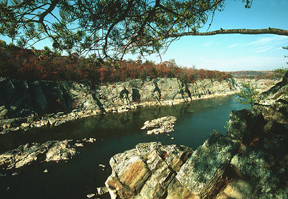 Geologists
have long thought that the Appalachian Mountains, which run 2,500 kilometers
from Canada to Alabama, were formed by three separate mountain-building events
over some 300 million years. New research is suggesting, however, that the Central
Appalachian Mountains likely formed through only one prolonged event.
Geologists
have long thought that the Appalachian Mountains, which run 2,500 kilometers
from Canada to Alabama, were formed by three separate mountain-building events
over some 300 million years. New research is suggesting, however, that the Central
Appalachian Mountains likely formed through only one prolonged event.The folded and faulted rocks along the Potomac River in Virginia indicate extreme metamorphism and complex geology. New research indicates that conventional thinking about the timing of the building of the Appalachian Mountains may be incorrect. Image copyright Gary P. Fleming.
All three mountain-building, or orogenic, events that were believed to have shaped the entire Appalachian chain occurred during the Paleozoic period. According to conventional wisdom, the Appalachians first started forming some 480 million years ago, as continents and land masses collided. The mountains then eroded away when the area was covered with a vast sea, only to rise again 400 to 350 million years ago, when plates recollided, with more erosion to follow. Around 280 to 265 million years ago, when Pangea began to form, the mountains again arose, and as blocks of continental crust rode over one another, the area’s rocks underwent intense metamorphism, folding and faulting.
Although this orogenic story has been around for decades, many scientists who have studied the region knew there was much more to learn. “From the 1800s to the early 1960s, the rocks of the piedmont to the Blue Ridge Mountains were pretty much called one unit, as they were too complicated to sort out,” says Scott Southworth, a geologist with the U.S. Geological Survey in Reston, Va. Since the 1960s, scientists have tried to differentiate one formation from another, but the extreme folds, untraceable faults and severely metamorphosed rocks have made it difficult, he says. Hoping to figure out the complicated heating and cooling history of the eastern portion of the Appalachians, Southworth, Michael Kunk and colleagues examined rocks along the Potomac River from western Virginia to Washington, D.C., as they reported in the September GSA Bulletin. They mapped the rocks and faults, and Kunk took samples back to a lab in Denver for isotopic dating.
The researchers analyzed 24 rock samples primarily using argon age-spectrum dating. The isotopic studies enabled Southworth and colleagues to differentiate rock formations within the Potomac terrane — a belt of folded and faulted rocks stretching from Pennsylvania to central Virginia — even ones that looked exactly the same. They also could now separate out rocks that underwent anomalously high-temperature and high-pressure periods. The results suggest that instead of three separate events that equally affected the mountain chain, this part of the Appalachians began growing in the Ordovician 480 million years ago, with periods of activity until 300 million years ago at least, Southworth says.
Furthermore, although “all three orogenic events can be demonstrated somewhere along the mountain chain,” they appear not to have occurred everywhere, he says. During the last 300-plus million years, significant deformation and metamorphism occurred, both on a smaller regional scale and on the larger scale.
“I think they’re quite right to point out that the history is quite complex … and their research is a good contribution,” says George Fisher, a geologist at Johns Hopkins University in Maryland, who started this discussion in 1963. And, he says, the basic age for the Appalachians, especially in the mid-Atlantic, is likely Ordovician with continuous deformation through the Triassic. On the other hand, he says, “I’m not sure that tectonic schemes” developed for one region of the Appalachians apply to another.
Nonetheless, Fisher says, Southworth and colleagues “have presented important new information that will help in creating a coherent regional picture.” Further isotopic dating, he says, especially using lead-uranium isotopes, would help to pin down more exactly the history of this complex region.

